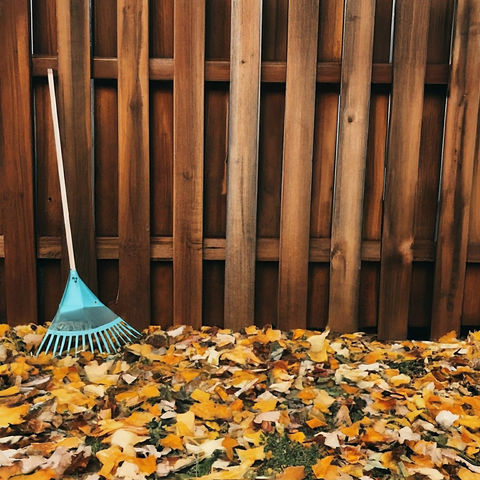Late Fall Yard Maintenance and Winter Prep in the Southern US
As the leaves begin to change and the temperatures start to drop, it's time to begin preparing your yard and fence for the coming winter months. Proper late fall and winter prep can help ensure your fence makes it through the cold weather in good condition.
Leaf Removal

One of the most important late fall chores is removing fallen leaves and debris. Depending on the types of trees in your yard, leaves can quickly pile up along your fence line. Wet, compacted leaves prevent air circulation and can lead to mold, mildew, and rot. Use a leaf blower or rake to clear leaves and other plant debris away from your fence perimeter. Be sure to get into corners and around fence posts where debris often accumulates. Removing leaves will allow sunlight and air to reach your fence, helping minimize moisture issues.
Drainage
Ensuring proper drainage around your fence line is also crucial for winter prep. Standing water caused by poor drainage can damage wood fences and lead to unstable soil conditions around vinyl and metal fences. Check that sprinklers are not pooling water near your fence. Use a rake to smooth and shape the ground to promote drainage away from the fence. If puddling is unavoidable due to the slope of your yard, consider diverting the water or digging a trench.
Fertilization
Apply a final fertilizer treatment in early fall. Fertilizing keeps plants and grass healthy going into winter dormancy. This helps prevent die off near the fence line, which reduces moisture issues from decaying organic matter. Choose a fertilizer appropriate for your grass type and follow package directions. Keep fertilizer away from fence posts and off of surfaces to avoid discoloration.
Inspect for Damage
Before winter, inspect your fence for any wear and tear incurred over the spring and summer. Check for loose or protruding nails, rotting wood, dents, cracking, or holes. Make all necessary repairs to prevent further damage over the winter. Look for spaces or cracking along the ground allowing animals like rodents or foxes to access the underside of your fence. Close up any gaps to prevent unwanted animals from nesting beneath your fence over the winter.
Sealing
For wood fences, apply waterproof sealant in late fall to protect the wood from winter weather. Power wash the fence first to remove built up dirt and mildew. Allow the fence to dry completely, then apply the sealant using a paintbrush or sprayer following the product directions. Choose a stain or sealer formulated for exterior wood. Sealing your fence annually helps maintain an attractive appearance and prevents moisture damage.
Check out our selection of incredible stains
from Stain and Seal Expert!
Gate Function
Assess all gates, latches, and hinges along your fence. Lubricate hinges to prevent sticking. Adjust any latches or hardware for proper closure. Test the open/close functions and repair as needed so gates function smoothly going into winter. Frozen precipitation and cold can lead to sticking or other opening issues if maintenance is not kept up.
Trim Vegetation
Trees, bushes, and grounds covers that touch your fence should be trimmed back in late fall. Trim any overhanging branches to prevent snow and ice accumulation which can damage fences. Keeping plants trimmed back improves air circulation as well. It also minimizes places for pests like rodents or spiders to nest over winter. Using Fence Armor Post Guards saves the post from damage to the protective layers and speed up rot and damage.
Your preparation this fall will pay off when your fence emerges next spring looking great and free of winter damage. With proper maintenance and care, your fence will continue enhancing your property for years to come.
















